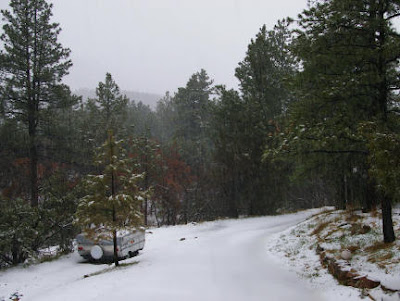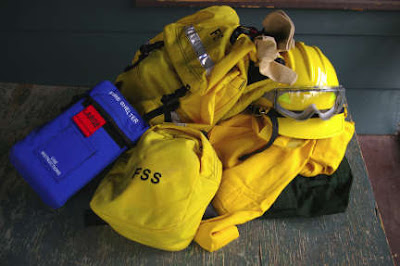I will be away from blogging for a week or a little more, visiting a different ecosystem.
See you later in May.
Where Nature Meets Culture—Plus Wildfire, Dogs, Environmental News, and Writing with a Southern Rockies Perspective.
April 27, 2009
April 22, 2009
Another Sure Sign of Spring
As sure a sign of spring as the return of hummingbirds is the news release from the Colorado Division of Wildlife advising people not to pick up "abandoned" babies.
It seems counter intuitive, but according to wildlife experts, it is normal to find young wild animals without an adult animal nearby. Well-meaning people sometimes scoop up baby wildlife and bring them to wildlife rehabilitation facilities, veterinary clinics, or Colorado Division of Wildlife offices, but experts say that is the wrong thing to do.
If you find young wildlife, enjoy a quick glimpse, leave the animal where it is, and keep pets out of the area.
"The best thing to do if you are concerned is to quietly observe the animal from a distance using binoculars. Don't hover so close that the wild parents are afraid to return to the area," advises Colorado Division of Wildlife Officer Jeromy Huntington.
"If several hours go by and the parent does not return, it is possible the newborn was abandoned or the parent is dead (hit by a car, for example) then report it to the Division of Wildlife. Do not move the animal yourself," he said.
Although M. and I did take the wildlife-transport class, we have not yet had any calls to transport critters.
It seems counter intuitive, but according to wildlife experts, it is normal to find young wild animals without an adult animal nearby. Well-meaning people sometimes scoop up baby wildlife and bring them to wildlife rehabilitation facilities, veterinary clinics, or Colorado Division of Wildlife offices, but experts say that is the wrong thing to do.
If you find young wildlife, enjoy a quick glimpse, leave the animal where it is, and keep pets out of the area.
"The best thing to do if you are concerned is to quietly observe the animal from a distance using binoculars. Don't hover so close that the wild parents are afraid to return to the area," advises Colorado Division of Wildlife Officer Jeromy Huntington.
"If several hours go by and the parent does not return, it is possible the newborn was abandoned or the parent is dead (hit by a car, for example) then report it to the Division of Wildlife. Do not move the animal yourself," he said.
Although M. and I did take the wildlife-transport class, we have not yet had any calls to transport critters.
April 21, 2009
The Noise of Summer Begins
The first of the hummingbird seasons started today with the arrival of a single male broad-tailed.
The earliest arrival that we have noted was on April 5, 2007, but I wonder if that bird survived, while the latest was about May 1, 1995, a year with an exceptionally cold, wet spring.
Often there is one last snowstorm after the first hummingbirds arrive. Did they fool us this year by out-waiting the spring storms?
The earliest arrival that we have noted was on April 5, 2007, but I wonder if that bird survived, while the latest was about May 1, 1995, a year with an exceptionally cold, wet spring.
Often there is one last snowstorm after the first hummingbirds arrive. Did they fool us this year by out-waiting the spring storms?
The Everett Ruess Mystery Solved?
 Via Odious and Peculiar, I learned today of a National Geographic Adventure piece offering a solution for the 1934 disappearance of the young artist Edward Ruess somewhere in the canyonlands of southern Utah.
Via Odious and Peculiar, I learned today of a National Geographic Adventure piece offering a solution for the 1934 disappearance of the young artist Edward Ruess somewhere in the canyonlands of southern Utah.A "vagabond for beauty," to use the subtitle of Bill Rusho's biography of him, Ruess spent part of three years exploring and making art, often alone, until vanishing. Speculation abounded: Was he killed by cattle rustlers? (There were some in the area.) Did he fall off the slickrock? Did he marry a rural Mormon girl or a Navajo and vanish into obscurity? Or was he murdered not by rustlers but by someone else?
The medicine man told Nez that the only way he could cure his cancer would be to retrieve a lock of hair from the head of the young man he had buried decades earlier, then use it in a five-day curing ceremony. "I was 19," Johnson said. "I was home for the summer. That was the first time I ever heard anything about the young dude the Utes had killed down there in Chinle Wash."
You could compare him to Christopher McCandless, but somehow Ruess comes across as a more sympathetic character, less egotistical and erratic, leaving behind an impression of talent cut short. When a friend finished reading the Rusho book, he said, "Now I remember what it was like to be 20."
The illustration is one of his linoleum cuts.
April 17, 2009
Ah, Spring

A mix of rain, sleet, snow, and fog started during the night and continues. The dogs react differently to it. Jack, the old Chessie (his 13th birthday was last Wednesday), pokes around in the brush, oblivious.
Oblivious for a while, that is -- the rug in front of the wood stove eventually charms him more.
Shelby the collie did not want to leave the verandah. I urged her down the steps -- surely she needed to pee! -- and just as she reached the bottom, there was a flash and a crack of thunder. She bolted back up the steps.
She does not like loud noises -- even a far-off gunshot bothers her. Jack, on the other hand, ignores thunder. Maybe it's a breed thing. And when he was a puppy and I saw him get a little nervous about an oncoming thunderstorm, I took him down the driveway, fed him dog biscuits, and told him that I would never let the thunder hurt him. He believed me.
M. and I have planted some early vegetables and annual flowers, so from the gardening perspective, this storm is wonderful.
April 12, 2009
Blog Stew with the Usual Carrion
• A scout-camera trifecta: mountain lion, wolf, and coyote. (Via Wolf Watch.)
• Stray dogs in Moscow take the subway to the city center to beg and scrounge, or so claims English Russia.
• Wildflowers are showing at the Pueblo Mountain Park, which is similar in habitat to my house. But you will not see them today, thanks to a nice soggy Easter snowstorm.
• Stray dogs in Moscow take the subway to the city center to beg and scrounge, or so claims English Russia.
• Wildflowers are showing at the Pueblo Mountain Park, which is similar in habitat to my house. But you will not see them today, thanks to a nice soggy Easter snowstorm.
April 11, 2009
Another Wildlife-related Festival: Plover in Karval

Maybe "festival" is too strong a word. But you have to start somewhere.
The town of Karval will host its Third Annual Mountain Plover Festival, April 24-26. This year's event adds new bird watching sites, a photography contest, and an extra day of activities including a Friday night stargazing trip. Karval is a farming hamlet, population "about 35," in southern Lincoln County. Registration deadline is April 15.
Despite their name, mountain plovers do not breed in the mountains, instead, they prefer shortgrass prairies. The eastern plains of Colorado are the primary breeding grounds for the mountain plover and more than half of the world's population nests in the state. Mountain plovers, are a considered a species of "special concern" in Colorado because of declining numbers.
"The Mountain Plover Festival is a great way for people to experience the small town atmosphere of a rural community while watching birds and learning about the culture and history of Colorado's eastern plains," said John Koshak, a watchable wildlife coordinator with the Colorado Division of Wildlife.
I once thought that some kind of corner in becoming rooted in place would be turned when we started having festivals more rooted in natural cycles.
And I don't care if someone at the Chamber of Commerce came up with the idea (see, for instance, Pueblo's Chile & Frijoles Festival) -- the message is bigger than that.
First came the Monte Vista Crane Festival, followed by Lamar's Goose Festival.
It's a trend, and a good one.
Mountain plover photo courtesy of the Colorado Division of Wildlife.
New Fire Gear
 It was like Christmas today at the fire house as we opened boxes of new wildland fire gear.
It was like Christmas today at the fire house as we opened boxes of new wildland fire gear.Things have been quiet lately. We have had some snow and rain, and the neighbors seem to be obeying the outdoor fire ban. So there is time for more training for us new guys before the season of lightning storms begins.
No more turning out in jeans and denim jacket and the old yellow hard hat that I had in the basement. The new fire pack replaces the ex-German Army rucksack I had kept my stuff in.
(All this new gear is so new, of course, that I am tempted to put it on and roll in the dirt.)
Meanwhile, we are preparing for the big chile cook-off. We talked about that today, discussed some key operational differences between the pumps on the two trucks -- and also discussed upgrading the telephone tree.
Many of us live out of earshot of the fire siren down at the county road shop, so we depend on a telephone tree -- a group of people (usually at home) who will in turn call a list of firefighters.
The discussion was enlightening. Mrs. So-and-so is increasingly hard of hearing -- do she and her husband even hear the siren if they have the TV on? Shouldn't someone replace her as one of the lead callers on the tree?
Neighbors A and B rarely turn out for fires unless their own homes are threatened -- move them down the list!
Neighbor C is all right, but he works outside the county these days, and if you catch him after 11 a.m. on a Saturday, he is usually on his way through a twelve-pack.
And Neighbor D is probably not physically up to anything beyond directing traffic anymore.
One volunteer assigned herself the task of calling everyone not present at today's work session and seeing if they still want to be on the telephone tree.
And that is how the work gets done in the fire-fighting "militia."
April 08, 2009
This Way to the Egret

Going to New Mexico meant seeing birds that we do not normally see, like this great egret, as migrating species follow the Rio Grande north.
(Historical pop-culture reference in blog post title.)
April 06, 2009
A Great Horned Owl at Home
 Last year when M. and I visited Libby and Steve Bodio, we looked in on this owl nest in Socorro County, New Mexico, but it was empty.
Last year when M. and I visited Libby and Steve Bodio, we looked in on this owl nest in Socorro County, New Mexico, but it was empty.But this year we saw a great horned owl on her nest.
They are one of my favorite species, not least for their weird variety of calls.
April 02, 2009
Subscribe to:
Posts (Atom)
